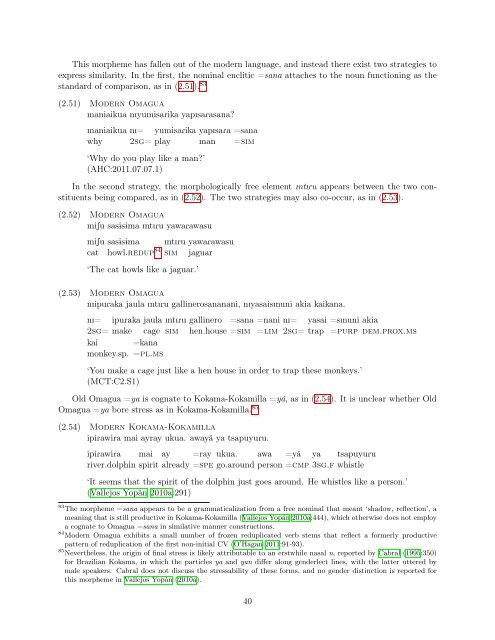draft manuscript - Linguistics - University of California, Berkeley
draft manuscript - Linguistics - University of California, Berkeley
draft manuscript - Linguistics - University of California, Berkeley
Create successful ePaper yourself
Turn your PDF publications into a flip-book with our unique Google optimized e-Paper software.
This morpheme has fallen out <strong>of</strong> the modern language, and instead there exist two strategies to<br />
express similarity. In the first, the nominal enclitic =sana attaches to the noun functioning as the<br />
standard <strong>of</strong> comparison, as in (2.51). 83<br />
(2.51) Modern Omagua<br />
maniaikua nIyumisaRika yapIsaRasana?<br />
maniaikua<br />
why<br />
nI= yumisaRika yapIsaRa =sana<br />
2sg= play man =sim<br />
‘Why do you play like a man?’<br />
(AHC:2011.07.07.1)<br />
In the second strategy, the morphologically free element IntIRu appears between the two constituents<br />
being compared, as in (2.52). The two strategies may also co-occur, as in (2.53).<br />
(2.52) Modern Omagua<br />
miSu sas1s1ma IntIRu yawaRawasu<br />
miSu<br />
cat<br />
sas1s1ma IntIRu yawaRawasu<br />
howl.redup 84 sim jaguar<br />
‘The cat howls like a jaguar.’<br />
(2.53) Modern Omagua<br />
nIipuRaka jaula IntIRu gallinerosananani, nIyasaisInuni akia kaikana.<br />
nI= ipuRaka jaula<br />
2sg= make cage<br />
kai =kana<br />
monkey.sp. =pl.ms<br />
IntIRu<br />
sim<br />
gallinero =sana =nani nI= yasai =sInuni akia<br />
hen.house =sim =lim 2sg= trap =purp dem.prox.ms<br />
‘You make a cage just like a hen house in order to trap these monkeys.’<br />
(MCT:C2.S1)<br />
Old Omagua =ya is cognate to Kokama-Kokamilla =yá, as in (2.54). It is unclear whether Old<br />
Omagua =ya bore stress as in Kokama-Kokamilla. 85<br />
(2.54) Modern Kokama-Kokamilla<br />
ipiRawiRa mai ayray ukua. awayá ya tsapuyuRu.<br />
ipiRawiRa mai ay =ray ukua. awa =yá ya tsapuyuRu<br />
river.dolphin spirit already =spe go.around person =cmp 3sg.f whistle<br />
‘It seems that the spirit <strong>of</strong> the dolphin just goes around. He whistles like a person.’<br />
(Vallejos Yopán 2010a:291)<br />
83 The morpheme =sana appears to be a grammaticalization from a free nominal that meant ‘shadow, reflection’, a<br />
meaning that is still productive in Kokama-Kokamilla (Vallejos Yopán 2010a:444), which otherwise does not employ<br />
a cognate to Omagua =sana in similative manner constructions.<br />
84 Modern Omagua exhibits a small number <strong>of</strong> frozen reduplicated verb stems that reflect a formerly productive<br />
pattern <strong>of</strong> reduplication <strong>of</strong> the first non-initial CV (O’Hagan 2011:91-93).<br />
85 Nevertheless, the origin <strong>of</strong> final stress is likely attributable to an erstwhile nasal n, reported by Cabral (1995:350)<br />
for Brazilian Kokama, in which the particles ya and yan differ along genderlect lines, with the latter uttered by<br />
male speakers. Cabral does not discuss the stressability <strong>of</strong> these forms, and no gender distinction is reported for<br />
this morpheme in Vallejos Yopán (2010a).<br />
40
















